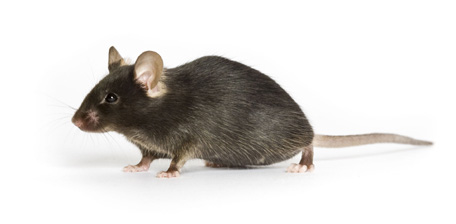It's easy to appreciate the diversity that exists among inbred mouse strains—coat color, breeding performance, disease susceptibility and many other traits vary so widely from one strain to another. The diversity of inbred mouse strains is reflected in the many genetic differences now known to exist among them (Keane 2011). By contrast, far less is known about the differences among substrains of even the most commonly used strain, C57BL/6 ("Black 6"). The C57BL/6 inbred strain was created by C.C. Little, the founder of The Jackson Laboratory. In 1951 two major branches of the C57BL/6 family tree diverged after a colony Black 6 mice was established at the National Institutes of Health. This led to the emergence of two substrains: C57BL/6N and C57BL/6J ("N" indicating mice descended from the National Institutes of Health colony, and "J" indicating The Jackson Laboratory's substrain, C57BL/6J (000664).
A substrain develops after a colony of mice is separated from its parental colony for 20 or more generations. Genetic drift during this time can lead to heritable differences between the colonies - for this reason we developed a unique Genetic Stability Program to counteract genetic drift in C57BL/6J and other popular strains. Substrains are identified by their nomenclature to indicate their origins and breeding history. C57BL/6J is the most frequently cited substrain and the first to be fully sequenced, while C57BL/6N has received added attention after it was selected as the strain background for the high-throughput mutations created by the Knockout Mouse Project (KOMP).

You may wonder what the key differences are between C57BL/6J and C57BL/6N and when one substrain is a more appropriate choice than the other. Despite their ubiquity in research, the two major C57BL/6 substrains had not been compared systematically for differences in genetics and phenotypes until recently. Research findings from a collaborating team of European scientists have shed light on many differences that exist between the two major C57BL/6 substrains (Simon et al. 2013).
By comparing C57BL/6N genomic sequences (including C57BL/6NJ (005304), the C57BL/6N substrain distributed by The Jackson Laboratory) to the C57BL/6J reference genome, the authors cataloged 34 single nucleotide polymorphisms (SNPs), two insertions/deletions ("indels") and 15 structural variants (which include copy number variations) that distinguish coding sequences of the two genomes. Differences in metabolism, locomotor activity, bone density, ophthalmology and many other traits were found when C57BL/6J and C57BL/6N mice were directly compared in a battery of physiological tests. Some of the differences identified in the screen could be linked to previously known genetic differences. For example, differences in glucose tolerance are likely related to the mutation in the Nnt (Nicotinamide nucleotide transhydrogenase) gene carried by C57BL/6J mice, while reduced vision in C57BL/6N mice is linked to the rd8 mutation of the Crb1 (crumbs homolog 1) gene involved in photoreceptor development pathways. The comparisons were performed in multiple laboratories to ensure reproducibility and also to identify areas where environmental differences could impact phenotypes.
References
Keene TM et al. 2011. Mouse genomic variation and its effect on phenotypes and gene regulation. Nature. 477(7364):289-94.
Simon MM et al. 2013. A comparative phenotypic and genomic analysis of C57BL/6J and C57BL/6N mouse strains. Genome Biol. 14(7):R82